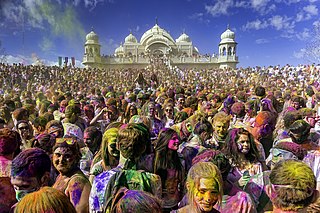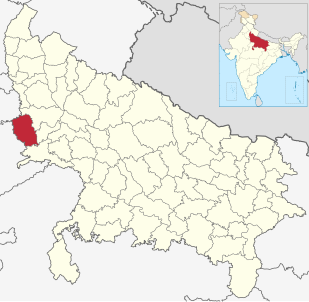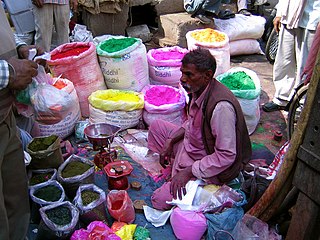
Holi is a popular ancient Hindu festival, originating from the Indian subcontinent. It is celebrated predominantly in India and Nepal, but has also spread to other areas of Asia and parts of the Western world through the diaspora from the Indian subcontinent. Holi is popularly known as the Indian "festival of spring", the "festival of colours", or the "festival of love". The festival signifies the arrival of spring, the end of winter, the blossoming of love, and for many a festive day to meet others, play and laugh, forget and forgive, and repair broken relationships. The festival also celebrates the beginning of a good spring harvest season. It lasts for a night and a day, starting on the evening of the Purnima falling in the Vikram Samvat Calendar, a Hindu calendar month of Falgun, which falls around middle of March in the Gregorian calendar. The first evening is known as Holika Dahan or Chhoti Holi and the following day as Holi, Rangwali Holi, Dhuleti, Dhulandi, or Phagwah.

Maha Shivaratri is a Hindu festival celebrated annually in honor of Lord Shiva, and in particular, marks the day of the marriage of Shiva. There is a Shivaratri in every luni-solar month of the Hindu calendar, on the month's 13th night/14th day, but once a year in late winter and before the arrival of Summer, marks Maha Shivaratri which means "the Great Night of Shiva".

Chaitra is a month of the Hindu calendar.

Bargarh is a municipality in Bargarh district in the state of Odisha, India. It is the administrative headquarters of Bargarh District. Popularly known for rice cultivation (parboiled-rice) therefore called "Bhata Handi" of Odisha State.

Shigmo or Shishirotsava is a spring festival celebrated in the Indian state of Goa, where it is one of the major festivals of the Hindu community. It is also celebrated by Konkani diaspora and Indian festival of Holi is part of it.

After the Mahābhārata battle, Barbarika's last wish was to see the war "Mahabharat" so Lord krishna himself placed his head on the top of a mountain for Barbarika to see the war. After many years when Kalyug started the head was found buried in the village of Khatu in present-day Rajasthan. The location was obscured until well after the Kaliyuga period began. Then, on one occasion, milk started flowing spontaneously out of a cow's udder when she neared the burial spot. Amazed at this incident, the local villagers dug the place up and the buried head was revealed. The head was handed over to a Brahmin who worshipped it for many days, awaiting divine revelations as to what was to be done next. Roopsingh Chauhan, king of Khatu, then had a dream where he was inspired to build a temple and install the head therein. Subsequently, a temple was built and the idol was installed on the 11th day of the Shukla Paksha of the month of Phagun.

Mathura district situated along the banks of the river Yamuna is a district of Uttar Pradesh state of northern India. The historic town of Mathura is the district headquarters. The District is part of Agra division. Mathura is bounded on the northeast by Aligarh District, on the southeast by Hathras District, on the south by Agra District, and on the west by Rajasthan and northwest by Haryana state. Mathura district is an important pilgrimage centre of Hindus. Many towns in the district Mathura have banned alcohol and non-vegetarian food.

Khatushyam is a temple situated in sikar district of Rajasthan,India. In Hinduism, Khatushyam is a name and manifestation of Barbareek, grandson of Bhim and Hidimba. This manifestation is especially popular in the Indian state of Rajasthan and Haryana. The original Sanskrit name Barbarīka is often replaced in Rajasthan by the Hindi version, Barbarīk, often written as Barbareek.

Khatushyamji or Khatu is a village of religious importance in Sikar District of Rajasthan in India. It is home to a famous temple of Khatushyam. It is one of the most sacred temples in India
This article lists the traditional festivals and other cultural events in the Odisha region of India.
Panguni Uthiram is a day of importance to Tamil Hindus. It falls on the day the moon transits in the asterism or nakshatram of Uttara-phalguni or Uthiram in the twelfth month of the Tamil calendar i.e. Panguni. It is the Purnima or full moon of the month of Panguni. This coincides with the Hindu calendar month of Phalguna / Chaitra.

Taharpur is a village in Jajpur district of Orissa State, India.

Sri Lakshmi Varaha Swamy Temple is a 500-year-old Indian temple dedicated to Varaha, the boar incarnation of Vishnu.

Venkanna Babu Kalyāṇōtsavām at Yanam is an annual festival at Yanam Venkanna Babu Temple celebrated for twenty four days in the month of Phālguṇa (February/March). The celebration attracts pilgrims and tourists from many parts of around Yanam. Kalyāṇam will be performed on Phālguṇa Śuddha Dvādaśi i.e., on the twelfth day of the festival.

Amalaka Ekadashi or Amalaki Ekadashi is a Hindu holy day, celebrated on the 11th day (Ekadashi) of the waxing moon, in the lunar month of Phalgun (February–March). It is a celebration of the amalaka or amla tree, known as the Indian gooseberry.

Chillā is the fifth month in the Nepal Era calendar, the national lunar calendar of Nepal. The month coincides with Phalguna (फागुन) in the Hindu lunar calendar and March in the Gregorian calendar.
Rang Panchami is a spring festival celebrated in Indian states- Maharashtra, Bihar, Uttar Pradesh, Madhya Pradesh and other parts of Northern India. In accordance with Hindu lunar calendar, this festival would be observed the fifth day of the Krishna Paksha, the waning phase of the moon during the month of Phalguna.












